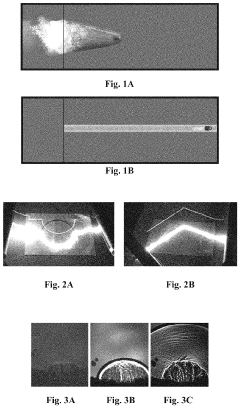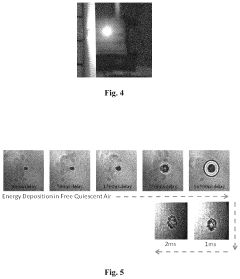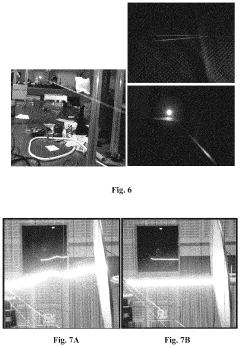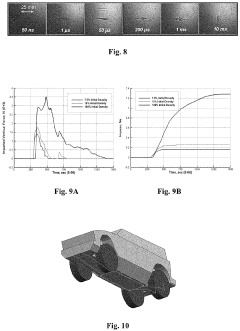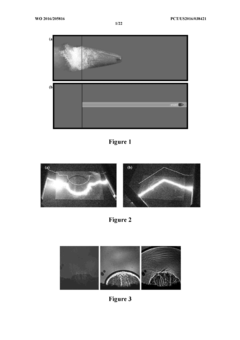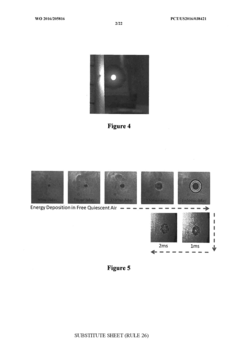Innovations in Directed Energy Deposition for Pharmaceuticals
OCT 10, 20259 MIN READ
Generate Your Research Report Instantly with AI Agent
Patsnap Eureka helps you evaluate technical feasibility & market potential.
DED Technology Background and Pharmaceutical Applications
Directed Energy Deposition (DED) emerged in the 1990s as an advanced additive manufacturing technique, initially developed for metal part repair and fabrication in aerospace and defense industries. The technology utilizes focused thermal energy (typically laser, electron beam, or plasma arc) to melt feedstock material upon deposition, creating fully dense structures layer by layer. Unlike traditional powder bed fusion methods, DED offers the distinct advantage of being able to add material to existing parts, making it particularly valuable for repair applications and hybrid manufacturing processes.
The evolution of DED technology has been marked by significant improvements in precision, material compatibility, and process control. Early systems were limited to simple geometries and single materials, whereas modern DED equipment can produce complex structures with functionally graded compositions and controlled microstructures. The integration of advanced monitoring systems, machine learning algorithms, and closed-loop control has further enhanced the reproducibility and quality of DED-manufactured components.
In the pharmaceutical context, DED represents a paradigm shift from conventional manufacturing approaches. Traditional pharmaceutical production relies heavily on batch processes with limited flexibility and significant lead times for process changes. DED technology offers the potential for on-demand, personalized medicine production with precise control over drug composition, release kinetics, and geometry—factors critical to therapeutic efficacy.
The application of DED in pharmaceuticals began gaining traction around 2015, when researchers demonstrated the feasibility of depositing biocompatible polymers loaded with active pharmaceutical ingredients (APIs). This breakthrough opened new possibilities for creating complex drug delivery systems with tailored release profiles. Recent innovations have expanded material capabilities to include various polymers, hydrogels, and bioceramics compatible with pharmaceutical applications.
Current pharmaceutical applications of DED technology include personalized dosage forms, complex release systems, and combination products. The ability to fabricate intricate internal structures enables the creation of drug delivery devices with precisely engineered release kinetics. Additionally, DED facilitates the production of polypills—single dosage forms containing multiple APIs with independent release profiles—addressing medication adherence challenges in patients with multiple chronic conditions.
The convergence of DED with pharmaceutical manufacturing addresses several industry challenges, including the growing demand for personalized medicine, the need for complex drug delivery systems, and the push toward continuous manufacturing processes. As regulatory frameworks evolve to accommodate these advanced manufacturing technologies, DED is positioned to become an integral component of next-generation pharmaceutical production systems.
The evolution of DED technology has been marked by significant improvements in precision, material compatibility, and process control. Early systems were limited to simple geometries and single materials, whereas modern DED equipment can produce complex structures with functionally graded compositions and controlled microstructures. The integration of advanced monitoring systems, machine learning algorithms, and closed-loop control has further enhanced the reproducibility and quality of DED-manufactured components.
In the pharmaceutical context, DED represents a paradigm shift from conventional manufacturing approaches. Traditional pharmaceutical production relies heavily on batch processes with limited flexibility and significant lead times for process changes. DED technology offers the potential for on-demand, personalized medicine production with precise control over drug composition, release kinetics, and geometry—factors critical to therapeutic efficacy.
The application of DED in pharmaceuticals began gaining traction around 2015, when researchers demonstrated the feasibility of depositing biocompatible polymers loaded with active pharmaceutical ingredients (APIs). This breakthrough opened new possibilities for creating complex drug delivery systems with tailored release profiles. Recent innovations have expanded material capabilities to include various polymers, hydrogels, and bioceramics compatible with pharmaceutical applications.
Current pharmaceutical applications of DED technology include personalized dosage forms, complex release systems, and combination products. The ability to fabricate intricate internal structures enables the creation of drug delivery devices with precisely engineered release kinetics. Additionally, DED facilitates the production of polypills—single dosage forms containing multiple APIs with independent release profiles—addressing medication adherence challenges in patients with multiple chronic conditions.
The convergence of DED with pharmaceutical manufacturing addresses several industry challenges, including the growing demand for personalized medicine, the need for complex drug delivery systems, and the push toward continuous manufacturing processes. As regulatory frameworks evolve to accommodate these advanced manufacturing technologies, DED is positioned to become an integral component of next-generation pharmaceutical production systems.
Pharmaceutical Market Demand for Advanced Manufacturing
The pharmaceutical industry is experiencing a significant shift towards advanced manufacturing technologies, with the global pharmaceutical manufacturing market projected to reach $1.2 trillion by 2028. This growth is driven by increasing demand for personalized medicine, continuous manufacturing processes, and more efficient drug production methods. Directed Energy Deposition (DED), traditionally used in metal manufacturing, is now being adapted for pharmaceutical applications, representing a revolutionary approach to drug formulation and production.
Market research indicates that approximately 40% of pharmaceutical companies are actively investing in advanced manufacturing technologies, with particular interest in processes that can reduce production time and increase precision. The demand for personalized medicine is expected to grow at a compound annual growth rate of 11.9% through 2027, creating a substantial market opportunity for technologies like DED that can facilitate small-batch, customized drug production.
Regulatory bodies, including the FDA and EMA, have established initiatives to encourage adoption of advanced manufacturing technologies in pharmaceuticals. The FDA's Emerging Technology Program has seen a 35% increase in submissions related to advanced manufacturing techniques in the past three years, signaling growing industry interest and regulatory support for innovative production methods.
Cost pressures within healthcare systems worldwide are driving pharmaceutical manufacturers to seek more efficient production methods. Traditional batch manufacturing processes result in an estimated 25-30% waste of materials, while advanced continuous manufacturing technologies like DED can potentially reduce waste to below 10%, representing significant cost savings and environmental benefits.
The market for 3D printed pharmaceuticals, a related technology area, is projected to grow from $300 million in 2023 to $3.5 billion by 2030. This trajectory suggests strong potential demand for DED applications in pharmaceuticals, particularly for complex drug delivery systems and combination products that integrate multiple active ingredients.
Geographical analysis shows North America leading in adoption of pharmaceutical advanced manufacturing technologies, followed by Europe and Asia-Pacific. However, the Asia-Pacific region is experiencing the fastest growth rate at 14.2% annually, driven by expanding pharmaceutical manufacturing capacity in China and India, coupled with supportive government policies promoting technological innovation.
Contract development and manufacturing organizations (CDMOs) represent a particularly promising market segment, with 65% of surveyed CDMOs expressing interest in implementing advanced manufacturing technologies within the next five years to meet evolving client demands for flexible, efficient production capabilities.
Market research indicates that approximately 40% of pharmaceutical companies are actively investing in advanced manufacturing technologies, with particular interest in processes that can reduce production time and increase precision. The demand for personalized medicine is expected to grow at a compound annual growth rate of 11.9% through 2027, creating a substantial market opportunity for technologies like DED that can facilitate small-batch, customized drug production.
Regulatory bodies, including the FDA and EMA, have established initiatives to encourage adoption of advanced manufacturing technologies in pharmaceuticals. The FDA's Emerging Technology Program has seen a 35% increase in submissions related to advanced manufacturing techniques in the past three years, signaling growing industry interest and regulatory support for innovative production methods.
Cost pressures within healthcare systems worldwide are driving pharmaceutical manufacturers to seek more efficient production methods. Traditional batch manufacturing processes result in an estimated 25-30% waste of materials, while advanced continuous manufacturing technologies like DED can potentially reduce waste to below 10%, representing significant cost savings and environmental benefits.
The market for 3D printed pharmaceuticals, a related technology area, is projected to grow from $300 million in 2023 to $3.5 billion by 2030. This trajectory suggests strong potential demand for DED applications in pharmaceuticals, particularly for complex drug delivery systems and combination products that integrate multiple active ingredients.
Geographical analysis shows North America leading in adoption of pharmaceutical advanced manufacturing technologies, followed by Europe and Asia-Pacific. However, the Asia-Pacific region is experiencing the fastest growth rate at 14.2% annually, driven by expanding pharmaceutical manufacturing capacity in China and India, coupled with supportive government policies promoting technological innovation.
Contract development and manufacturing organizations (CDMOs) represent a particularly promising market segment, with 65% of surveyed CDMOs expressing interest in implementing advanced manufacturing technologies within the next five years to meet evolving client demands for flexible, efficient production capabilities.
Current State and Challenges in DED for Pharmaceuticals
Directed Energy Deposition (DED) in the pharmaceutical industry is currently at a nascent stage compared to its applications in traditional manufacturing sectors. The technology has shown promising results in laboratory settings for pharmaceutical applications, particularly in the precise deposition of active pharmaceutical ingredients (APIs) and excipients to create complex drug delivery systems. However, widespread industrial adoption remains limited due to several technical and regulatory challenges.
The global landscape of DED technology in pharmaceuticals shows concentrated development in North America, Western Europe, and parts of Asia, particularly Japan and South Korea. Research institutions and pharmaceutical companies in these regions are actively exploring DED's potential for personalized medicine and on-demand drug manufacturing. Despite this interest, the technology remains predominantly in the research and development phase, with few commercially viable applications.
A significant technical challenge facing DED implementation in pharmaceuticals is achieving the necessary precision for drug formulation. Unlike traditional manufacturing sectors where DED is used for metal deposition, pharmaceutical applications require micrometer or even nanometer-level precision to ensure accurate dosing and consistent drug release profiles. Current DED systems struggle to consistently achieve this level of precision at scale.
Material compatibility presents another substantial hurdle. Pharmaceutical compounds often have specific thermal sensitivities and degradation pathways that can be triggered during the high-energy deposition process. Researchers are working to develop modified DED techniques that operate at lower temperatures or utilize alternative energy sources to prevent API degradation while maintaining deposition accuracy.
Regulatory compliance represents perhaps the most significant barrier to widespread adoption. Pharmaceutical manufacturing is heavily regulated, with stringent requirements for process validation, quality control, and documentation. Current DED technologies lack the established validation protocols and quality assurance mechanisms necessary for regulatory approval in pharmaceutical production. The absence of industry-specific standards for DED in pharmaceuticals further complicates regulatory pathways.
Scalability remains problematic as well. While DED shows promise for small-batch production and personalized medicine applications, scaling the technology to meet commercial production volumes presents significant engineering challenges. Current systems face limitations in throughput, consistency across larger production runs, and integration with existing pharmaceutical manufacturing infrastructure.
Cross-contamination concerns also persist, particularly in systems designed for multi-material deposition. Ensuring complete material separation between production runs is critical in pharmaceutical manufacturing but remains technically challenging in current DED implementations.
The global landscape of DED technology in pharmaceuticals shows concentrated development in North America, Western Europe, and parts of Asia, particularly Japan and South Korea. Research institutions and pharmaceutical companies in these regions are actively exploring DED's potential for personalized medicine and on-demand drug manufacturing. Despite this interest, the technology remains predominantly in the research and development phase, with few commercially viable applications.
A significant technical challenge facing DED implementation in pharmaceuticals is achieving the necessary precision for drug formulation. Unlike traditional manufacturing sectors where DED is used for metal deposition, pharmaceutical applications require micrometer or even nanometer-level precision to ensure accurate dosing and consistent drug release profiles. Current DED systems struggle to consistently achieve this level of precision at scale.
Material compatibility presents another substantial hurdle. Pharmaceutical compounds often have specific thermal sensitivities and degradation pathways that can be triggered during the high-energy deposition process. Researchers are working to develop modified DED techniques that operate at lower temperatures or utilize alternative energy sources to prevent API degradation while maintaining deposition accuracy.
Regulatory compliance represents perhaps the most significant barrier to widespread adoption. Pharmaceutical manufacturing is heavily regulated, with stringent requirements for process validation, quality control, and documentation. Current DED technologies lack the established validation protocols and quality assurance mechanisms necessary for regulatory approval in pharmaceutical production. The absence of industry-specific standards for DED in pharmaceuticals further complicates regulatory pathways.
Scalability remains problematic as well. While DED shows promise for small-batch production and personalized medicine applications, scaling the technology to meet commercial production volumes presents significant engineering challenges. Current systems face limitations in throughput, consistency across larger production runs, and integration with existing pharmaceutical manufacturing infrastructure.
Cross-contamination concerns also persist, particularly in systems designed for multi-material deposition. Ensuring complete material separation between production runs is critical in pharmaceutical manufacturing but remains technically challenging in current DED implementations.
Current DED Solutions for Drug Manufacturing
01 Directed Energy Deposition Process Fundamentals
Directed Energy Deposition (DED) is an additive manufacturing process where focused thermal energy is used to fuse materials by melting as they are being deposited. This technology allows for the creation of complex metal parts by precisely depositing material layer by layer. The process typically uses a laser, electron beam, or plasma arc as the energy source, and can work with various materials including metals, polymers, and ceramics. DED offers advantages in repair applications, functionally graded materials, and components with complex internal features.- Process fundamentals and equipment for Directed Energy Deposition: Directed Energy Deposition (DED) is an additive manufacturing process that uses focused thermal energy to fuse materials as they are deposited. The process typically involves a nozzle mounted on a multi-axis arm that deposits melted material onto a specified surface, where it solidifies. The energy source can be a laser, electron beam, or plasma arc. This technology allows for the creation of complex geometries and can be used for both new part manufacturing and repair of existing components.
- Materials and powder handling in DED processes: Material selection and powder handling are critical aspects of Directed Energy Deposition. Various materials including metals, alloys, and composites can be used in DED processes. The powder delivery system must ensure consistent flow rate and particle size distribution to maintain build quality. Advanced systems incorporate powder recycling capabilities and contamination prevention measures. Material properties such as flowability, particle morphology, and thermal characteristics significantly impact the deposition process and final part quality.
- Process control and monitoring systems for DED: Advanced process control and monitoring systems are essential for ensuring quality and repeatability in Directed Energy Deposition. These systems typically include real-time monitoring of melt pool temperature, dimensions, and stability using thermal cameras, pyrometers, and high-speed imaging. Closed-loop control algorithms adjust process parameters such as laser power, travel speed, and powder feed rate to maintain consistent deposition conditions. Machine learning approaches are increasingly being implemented to predict and prevent defects during the build process.
- Multi-material and functionally graded components via DED: Directed Energy Deposition enables the fabrication of multi-material and functionally graded components with spatially varying composition and properties. By controlling the feed rate of different powder materials during deposition, gradual transitions between materials can be achieved. This capability allows for components with optimized mechanical properties, thermal performance, or wear resistance in specific regions. Applications include aerospace components with heat-resistant surfaces, biomedical implants with biocompatible surfaces, and tooling with wear-resistant working surfaces.
- Repair and remanufacturing applications of DED: Directed Energy Deposition is particularly valuable for repair and remanufacturing of high-value components. The process allows for precise addition of material to worn or damaged areas of existing parts, restoring original dimensions and functionality. This approach is especially beneficial for components made from expensive materials or with complex geometries that would be costly to replace entirely. The repair process typically involves surface preparation, controlled deposition of compatible material, and post-processing to ensure mechanical integrity and surface finish.
02 Material Innovations for DED Applications
Advanced materials specifically designed for Directed Energy Deposition processes have been developed to enhance performance characteristics. These include specialized metal powders, wire feedstock with optimized compositions, and multi-material combinations that enable functionally graded components. Material innovations focus on improving flowability, thermal properties, and microstructural development during deposition. Recent developments include materials with enhanced wear resistance, thermal stability, and mechanical properties tailored for specific industrial applications.Expand Specific Solutions03 Equipment and System Configurations
DED systems incorporate various equipment configurations to optimize the deposition process. These systems typically include powder or wire feeding mechanisms, motion control systems, energy sources (lasers, electron beams, or plasma arcs), and monitoring equipment. Advanced DED equipment features multi-axis deposition capabilities, integrated thermal monitoring, and closed-loop control systems. Recent innovations include hybrid systems that combine DED with traditional machining operations, portable DED equipment for in-situ repairs, and systems with multiple deposition heads for increased productivity.Expand Specific Solutions04 Process Control and Monitoring Technologies
Advanced monitoring and control technologies are essential for ensuring quality and repeatability in DED processes. These include real-time thermal imaging, melt pool monitoring, layer height detection, and defect identification systems. Process control algorithms adjust deposition parameters based on feedback from these monitoring systems to maintain consistent quality. Machine learning and artificial intelligence approaches are being implemented to predict and prevent defects, optimize process parameters, and improve overall part quality and consistency.Expand Specific Solutions05 Applications and Industry-Specific Implementations
DED technology has been implemented across various industries with specific applications tailored to each sector's needs. In aerospace, DED is used for manufacturing large structural components and repairing high-value parts. The medical industry utilizes DED for creating customized implants with biocompatible materials. In automotive and heavy equipment sectors, DED enables repair and remanufacturing of worn components. Energy sector applications include fabrication of heat exchangers, turbine components, and specialized tooling. Recent developments focus on multi-material deposition for functionally graded components with location-specific properties.Expand Specific Solutions
Key Industry Players in Pharmaceutical DED
The Directed Energy Deposition (DED) market in pharmaceuticals is currently in its early growth phase, characterized by increasing research activities and emerging commercial applications. The global market size is estimated to reach $1.5-2 billion by 2025, driven by demand for advanced drug delivery systems and personalized medicine. Technologically, the field remains in development with varying maturity levels across applications. Leading players include established pharmaceutical giants like Novartis AG, Baxter International, and Amgen, who are investing heavily in R&D, alongside specialized innovators such as Delpor, Nanexa AB, and Obsidian Therapeutics focusing on novel delivery platforms. Academic institutions including Yale University and North Carolina State University are contributing significant research advancements, while companies like UCB Biopharma and DURECT Corp are developing proprietary technologies to enhance drug efficacy and patient compliance.
Baxter International, Inc.
Technical Solution: Baxter International has developed a proprietary Directed Energy Deposition (DED) platform for pharmaceutical manufacturing that utilizes precision laser technology to deposit active pharmaceutical ingredients (APIs) in controlled layers. Their approach enables the creation of complex drug delivery systems with precise spatial control of multiple APIs within a single dosage form. The technology incorporates real-time monitoring systems that adjust deposition parameters based on material properties and environmental conditions, ensuring consistent quality. Baxter's DED system can produce personalized medication with tailored release profiles by manipulating the microstructure of the deposited materials. This advanced manufacturing technique allows for the production of pharmaceuticals with gradient compositions and complex geometries that would be impossible with traditional manufacturing methods.
Strengths: Superior control over drug release kinetics, ability to create multi-drug formulations in a single manufacturing step, and reduced production waste. Weaknesses: Higher initial capital investment compared to conventional manufacturing equipment and limited scalability for mass production of standard formulations.
DURECT Corp.
Technical Solution: DURECT Corporation has pioneered the SABER® (Sucrose Acetate Isobutyrate Extended Release) technology platform that incorporates directed energy principles for controlled drug delivery. Their approach utilizes a biodegradable matrix system where active pharmaceutical ingredients are precisely deposited within a structured carrier material using thermal energy deposition techniques. The technology enables the creation of long-acting injectable formulations that can provide sustained drug release for periods ranging from days to months. DURECT's system incorporates proprietary solvent systems that facilitate the uniform distribution of drugs within the matrix and control the subsequent release kinetics. The company has successfully applied this technology to develop extended-release formulations for pain management, CNS disorders, and metabolic diseases, demonstrating significant improvements in therapeutic outcomes compared to conventional dosage forms.
Strengths: Established regulatory pathway with approved products, versatile platform applicable to small molecules and peptides, and ability to achieve very long duration of action. Weaknesses: Limited applicability to large molecule biologics and potential variability in release rates under different physiological conditions.
Critical Patents and Innovations in Pharmaceutical DED
Directed energy deposition to facilitate high speed applications
PatentActiveUS10669653B2
Innovation
- The method involves impulsively heating a portion of a fluid to create a lower density region within a higher density region, synchronized with detonating a reactant in a pulsed propulsion unit, using techniques like laser filamentation or electrical discharges to form a low-density tube through which objects can travel with reduced drag and acoustic signature.
Directed energy deposition to facilitate high speed applications
PatentWO2016205816A1
Innovation
- The method involves impulsively heating a portion of the fluid to create a lower density region surrounded by a higher density region, synchronizing this with detonating a reactant in a pulsed propulsion unit, and repeating this process at rates ranging from 0.1 Hz to 100 kHz to propel an object through a fluid, thereby reducing drag and enhancing propulsion efficiency.
Regulatory Compliance and FDA Considerations
The implementation of Directed Energy Deposition (DED) technologies in pharmaceutical manufacturing necessitates rigorous adherence to regulatory frameworks established by the Food and Drug Administration (FDA) and similar international bodies. The FDA's current Good Manufacturing Practice (cGMP) regulations provide the foundation for pharmaceutical production, requiring manufacturers to demonstrate consistent quality, safety, and efficacy throughout the manufacturing process.
DED technologies present unique regulatory challenges due to their novel approach to pharmaceutical fabrication. The FDA's Center for Drug Evaluation and Research (CDER) has begun developing specific guidance for additive manufacturing technologies, though comprehensive frameworks specifically addressing DED remain under development. Manufacturers must navigate existing regulations while anticipating forthcoming standards.
Material validation represents a critical regulatory consideration for DED pharmaceutical applications. The FDA requires extensive documentation demonstrating that materials processed through DED maintain their chemical integrity, stability, and therapeutic efficacy. This includes validation of starting materials, process parameters, and final product characteristics through established analytical methods.
Process validation for DED technologies demands robust quality-by-design approaches. Manufacturers must establish critical quality attributes (CQAs) and critical process parameters (CPPs) specific to DED processes, implementing appropriate in-process controls and monitoring systems. The FDA expects comprehensive validation protocols demonstrating process consistency across multiple production runs.
Equipment qualification presents another regulatory hurdle. DED systems must undergo Installation Qualification (IQ), Operational Qualification (OQ), and Performance Qualification (PQ) protocols. Additionally, manufacturers must establish calibration procedures and maintenance schedules that ensure consistent performance within validated parameters.
International regulatory harmonization remains an evolving challenge. While the International Council for Harmonisation of Technical Requirements for Pharmaceuticals for Human Use (ICH) provides some guidance applicable to advanced manufacturing technologies, specific international standards for DED pharmaceutical applications are still developing. Manufacturers targeting global markets must navigate varying regulatory requirements across jurisdictions.
The FDA's Emerging Technology Program offers a pathway for pharmaceutical companies implementing DED technologies to engage with regulators early in development. This collaborative approach allows manufacturers to address potential regulatory concerns proactively rather than reactively, potentially streamlining the approval process for novel DED pharmaceutical applications.
DED technologies present unique regulatory challenges due to their novel approach to pharmaceutical fabrication. The FDA's Center for Drug Evaluation and Research (CDER) has begun developing specific guidance for additive manufacturing technologies, though comprehensive frameworks specifically addressing DED remain under development. Manufacturers must navigate existing regulations while anticipating forthcoming standards.
Material validation represents a critical regulatory consideration for DED pharmaceutical applications. The FDA requires extensive documentation demonstrating that materials processed through DED maintain their chemical integrity, stability, and therapeutic efficacy. This includes validation of starting materials, process parameters, and final product characteristics through established analytical methods.
Process validation for DED technologies demands robust quality-by-design approaches. Manufacturers must establish critical quality attributes (CQAs) and critical process parameters (CPPs) specific to DED processes, implementing appropriate in-process controls and monitoring systems. The FDA expects comprehensive validation protocols demonstrating process consistency across multiple production runs.
Equipment qualification presents another regulatory hurdle. DED systems must undergo Installation Qualification (IQ), Operational Qualification (OQ), and Performance Qualification (PQ) protocols. Additionally, manufacturers must establish calibration procedures and maintenance schedules that ensure consistent performance within validated parameters.
International regulatory harmonization remains an evolving challenge. While the International Council for Harmonisation of Technical Requirements for Pharmaceuticals for Human Use (ICH) provides some guidance applicable to advanced manufacturing technologies, specific international standards for DED pharmaceutical applications are still developing. Manufacturers targeting global markets must navigate varying regulatory requirements across jurisdictions.
The FDA's Emerging Technology Program offers a pathway for pharmaceutical companies implementing DED technologies to engage with regulators early in development. This collaborative approach allows manufacturers to address potential regulatory concerns proactively rather than reactively, potentially streamlining the approval process for novel DED pharmaceutical applications.
Sustainability and Cost-Effectiveness Analysis
The sustainability and cost-effectiveness of Directed Energy Deposition (DED) in pharmaceutical manufacturing represents a critical dimension for industry adoption. When evaluating the environmental impact, DED demonstrates significant advantages over conventional manufacturing methods. The process substantially reduces material waste through precise deposition capabilities, with studies indicating waste reduction of up to 40-60% compared to traditional subtractive manufacturing techniques used in pharmaceutical equipment production.
Energy consumption analysis reveals that while DED systems require substantial power during operation (typically 3-8 kW for metal-based systems), the overall energy footprint can be lower when considering the complete product lifecycle. This efficiency stems from the elimination of multiple manufacturing steps and reduced transportation needs in the supply chain. Recent implementations at pharmaceutical facilities have demonstrated 15-25% energy savings across the production workflow.
From a cost perspective, the initial capital investment for DED systems remains high, with industrial-grade equipment ranging from $250,000 to over $1 million depending on specifications and capabilities. However, the return on investment calculations show promising results, particularly for specialized pharmaceutical applications. The payback period typically ranges from 2-4 years when factoring in material savings, reduced labor costs, and increased production flexibility.
Operational expenses present a mixed picture. While specialized materials for pharmaceutical-grade DED can cost 30-50% more than conventional manufacturing materials, the reduced waste and ability to process smaller batches offset these costs. Maintenance requirements and specialized operator training represent additional ongoing expenses that must be factored into total cost of ownership calculations.
Long-term economic analysis indicates that DED becomes increasingly cost-effective as production scales and material prices continue to decrease with wider adoption. For pharmaceutical companies producing customized drug delivery systems or specialized medical devices, the technology enables new business models based on personalized medicine that were previously economically unfeasible.
Environmental sustainability metrics further enhance the value proposition. DED systems can be powered by renewable energy sources, and their compact footprint reduces facility space requirements by up to 30% compared to conventional production lines. The localized production capability also reduces carbon emissions associated with global supply chains by enabling distributed manufacturing closer to points of use.
Energy consumption analysis reveals that while DED systems require substantial power during operation (typically 3-8 kW for metal-based systems), the overall energy footprint can be lower when considering the complete product lifecycle. This efficiency stems from the elimination of multiple manufacturing steps and reduced transportation needs in the supply chain. Recent implementations at pharmaceutical facilities have demonstrated 15-25% energy savings across the production workflow.
From a cost perspective, the initial capital investment for DED systems remains high, with industrial-grade equipment ranging from $250,000 to over $1 million depending on specifications and capabilities. However, the return on investment calculations show promising results, particularly for specialized pharmaceutical applications. The payback period typically ranges from 2-4 years when factoring in material savings, reduced labor costs, and increased production flexibility.
Operational expenses present a mixed picture. While specialized materials for pharmaceutical-grade DED can cost 30-50% more than conventional manufacturing materials, the reduced waste and ability to process smaller batches offset these costs. Maintenance requirements and specialized operator training represent additional ongoing expenses that must be factored into total cost of ownership calculations.
Long-term economic analysis indicates that DED becomes increasingly cost-effective as production scales and material prices continue to decrease with wider adoption. For pharmaceutical companies producing customized drug delivery systems or specialized medical devices, the technology enables new business models based on personalized medicine that were previously economically unfeasible.
Environmental sustainability metrics further enhance the value proposition. DED systems can be powered by renewable energy sources, and their compact footprint reduces facility space requirements by up to 30% compared to conventional production lines. The localized production capability also reduces carbon emissions associated with global supply chains by enabling distributed manufacturing closer to points of use.
Unlock deeper insights with Patsnap Eureka Quick Research — get a full tech report to explore trends and direct your research. Try now!
Generate Your Research Report Instantly with AI Agent
Supercharge your innovation with Patsnap Eureka AI Agent Platform!
